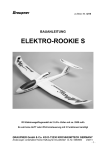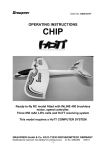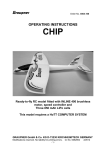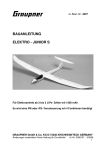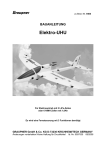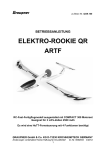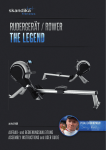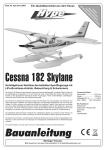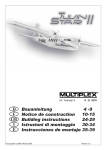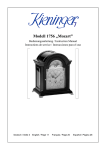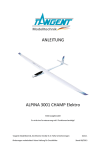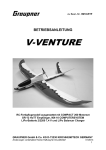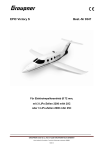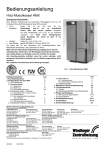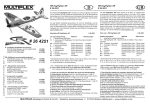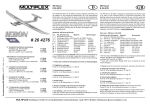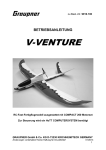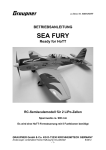Download 0060560-4218- ELEKTRO- ROOKIE S-DE-EN-FR
Transcript
zu Best.-Nr. 4218 BAUANLEITUNG ELEKTRO-ROOKIE S RC-Elektrosegelflugmodell ab 2 LiPo- Zellen mit ca. 2500 mAh Es wird eine FM oder iFS-Fernsteuerung mit 3 Funktionen benötigt GRAUPNER GmbH & Co. KG D-73230 KIRCHHEIM/TECK GERMANY Änderungen vorbehalten! Keine Haftung für Druckfehler! Id.-Nr. 0060560 12/2009 -1- Bitte unbedingt die folgenden Sicherheitshinweise beachten. Sofern das Modell an eine andere Person weitergegeben wird, müssen diese Sicherheitshinweise, bzw. die komplette Bauanleitung zur Beachtung weitergegeben werden. Sicherheitshinweise Für den Betrieb Ihres Flugmodells benötigen Sie eine gültige Haftpflichtversicherung, dies ist vom Gesetzgeber so vorgeschrieben. Vor dem Versuch der ersten Inbetriebnahme muss die gesamte Betriebs- bzw. Bauanleitung sorgfältig gelesen werden. Sie alleine sind verantwortlich für den sicheren Betrieb Ihres RCFlugmodells. Bei Jugendlichen muss der Bau und Betrieb von einem Erwachsenen, der mit den Gegebenheiten und möglichen Gefahren eines RC-Flugmodells vertraut ist, verantwortlich überwacht werden. Rechtlich gesehen, ist ein Flugmodell ein Luftfahrzeug und unterliegt entsprechenden Gesetzen, die unbedingt eingehalten werden müssen. Die Broschüre »Modellflugrecht, Paragrafen und mehr«, Best.-Nr. 8034.02 stellt eine Zusammenfassung dieser Gesetze dar; sie kann auch beim Fachhandel eingesehen werden. Ferner müssen postalische Auflagen für die Fernlenkanlage beachtet werden. Entsprechende Hinweise finden Sie in der Bedienungsanleitung Ihrer Fernsteueranlage. Es dürfen nur die in dem Bausatz enthaltenen Teile, sowie die ausdrücklich von uns empfohlenen Original-Graupner-Zubehör- und Ersatzteile verwendet werden. Wird eine Komponente der Antriebseinheit geändert, ist ein sicherer Betrieb nicht mehr gewährleistet und es erlischt jeglicher Garantieanspruch. Kurzschlüsse und Falschpolungen vermeiden. Durch die hohe Energie der Batterien besteht Explosions- und Brandgefahr. Ein RC-Flugmodell kann nur funktionsfähig sein und den Erwartungen entsprechen, wenn es im Sinne der Bauanleitung sorgfältigst gebaut wurde. Nur ein vorsichtiger und überlegter Umgang beim Betrieb schützt vor Personen- und Sachschäden. Niemand würde sich in ein Segelflugzeug setzen und - ohne vorausgegangene Schulung - versuchen, damit zu fliegen. Erfolgreiches Modellfliegen erfordert ebenso eine Ausbildungs- bzw. Übungsphase. Der Hersteller hat jedoch keine Möglichkeit, den Bau und den Betrieb eines RC-Flugmodells zu beeinflussen. Deshalb wird hiermit auf die Gefahren nachdrücklich hingewiesen und jede Haftung dafür abgelehnt. Bitte wenden Sie sich dazu an erfahrene Modellflieger, an Vereine oder Modellflugschulen. Ferner sei auf den Fachhandel und die einschlägige Fachpresse verwiesen. Am besten als Club-Mitglied auf zugelassenem Modellflugplatz fliegen. Klebstoffe enthalten Inhaltsstoffe, die unter Umständen gesundheitsschädlich sein können. Beachten Sie daher unbedingt auch die entsprechenden Hinweise und Warnungen der Hersteller. Der Betreiber muss im Besitz seiner vollen körperlichen und geistigen Fähigkeiten sein. Wie beim Autofahren, ist der Betrieb des Flugmodells unter Alkohol oder Drogeneinwirkung nicht erlaubt. Informieren Sie Passanten und Zuschauer vor der Inbetriebnahme über Gefahren, die von Ihrem Modell ausgehen und ermahnen Sie diese, sich in ausreichendem Schutzabstand aufzuhalten. Stets mit dem notwendigen Sicherheitsabstand zu Personen oder Hindernissen fliegen, nie Personen überfliegen oder auf sie zufliegen! Modellflug darf nur bei Außentemperaturen von - 5º C bis + 35º C betrieben werden. Extreme Temperaturen können zu Veränderungen der Batteriekapazität, der Werkstoffeigenschaften sowie z. B. zu mangelhaften Klebeverbindungen u.s.w. führen. GRAUPNER GmbH & Co. KG D-73230 KIRCHHEIM/TECK GERMANY Änderungen vorbehalten! Keine Haftung für Druckfehler! Id.-Nr. 0060560 12/2009 -2- Jeder Modellflieger hat sich so zu verhalten, dass die öffentliche Sicherheit, insbesondere andere Personen und Sachen, sowie der Ablauf des Modellflugbetriebs nicht gefährdet oder gestört wird. Das Flugmodell niemals in der Nähe von Hochspannungsleitungen, Industriegeländen, in Wohngebieten, öffentlichen Straßen, Schulhöfen oder Spielplätzen usw. fliegen lassen. Überprüfung vor dem Start Vor jedem Einsatz korrekte Funktion überprüfen. Dazu den Sender einschalten, ebenso den Empfänger. Senderantenne ausziehen, kontrollieren ob alle Ruder in Neutrallage stehen, einwandfrei funktionieren und seitenrichtig ausschlagen. Diese Überprüfung bei laufendem Motor wiederholen, während ein Helfer das Modell festhält. Beim erstmaligen Steuern eines Flugmodells ist es von Vorteil, wenn ein erfahrener Helfer bei der Überprüfung und den ersten Flügen zur Seite steht. Warnungen müssen unbedingt beachtet werden. Sie beziehen sich auf Dinge und Vorgänge, die bei einer Nichtbeachtung zu schweren - in Extremfällen tödlichen Verletzungen oder bleibenden Schäden führen können. Luftschrauben die durch einen Motor angetrieben werden, stellen eine ständige Verletzungsgefahr dar. Sie dürfen mit keinem Körperteil berührt werden! Eine schnell drehende Luftschraube kann z. B. einen Finger einschneiden! Sich niemals in oder vor der Drehebene von Luftschrauben aufhalten! Es könnte sich doch einmal ein Teil davon oder die komplette Luftschraube lösen und mit hoher Geschwindigkeit und viel Energie wegfliegen und Sie oder Dritte treffen. Dies kann u. U. zu schweren Verletzungen führen . Darauf achten, dass kein sonstiger Gegenstand mit einer laufenden Luftschraube in Berührung kommt! Die Blockierung der Luftschraube, durch irgendwelche Teile, muss ausgeschlossen sein. Überprüfen Sie vor jeder Inbetriebnahme das Modell und alle an ihm gekoppelten Teile (z. B. Luftschrauben, RC-Teile usw.) auf festen Sitz und mögliche Beschädigungen. Das Modell darf erst nach Beseitigung aller Mängel in Betrieb genommen werden. Vergewissern Sie sich, dass die verwendete Sender- Frequenz frei ist. Erst dann den Sender einschalten! Funkstörungen, verursacht durch Unbekannte, können stets ohne Vorwarnung auftreten! Das Modell ist dann steuerlos und unberechenbar! Fernlenkanlage nicht unbeaufsichtigt lassen, um ein Betätigen durch Dritte zu verhindern. Elektromotor nur einschalten, wenn nichts im Drehbereich der Luftschraube ist. Nicht versuchen, die laufende Luftschraube anzuhalten. Elektromotor mit Luftschraube nur im eingebauten Zustand betreiben. Die Fluglage des Modells muss während des gesamten Fluges immer eindeutig erkennbar sein, um immer ein sicheres Steuern und Ausweichen zu gewährleisten. Machen sich während des Fluges Funktionsbeeinträchtigungen/Störungen bemerkbar, muss aus Sicherheitsgründen sofort die Landung eingeleitet werden. Sie haben anderen Luftfahrzeugen stets auszuweichen. Start- und Landeflächen müssen frei von Personen und sonstigen Hindernissen sein. Immer auf vollgeladene Batterien achten, da sonst keine einwandfreie Funktion der RC-Anlage gewährleistet ist. Niemals heiß gewordene, defekte oder beschädigte Batterien verwenden. Es sind stets die Gebrauchsvorschriften des Batterieherstellers zu beachten. Vor jedem Flug eine Überprüfung der kompletten RC-Anlage, sowie des Flugmodells, auf volle Funktionstüchtigkeit und Reichweite durchführen. Dabei ist zu beachten, dass bei der Inbetriebnahme die Motorsteuerfunktion am Sender immer zuerst in AUS-Stellung gebracht wird. Danach Sender und dann erst Empfangsanlage GRAUPNER GmbH & Co. KG D-73230 KIRCHHEIM/TECK GERMANY Änderungen vorbehalten! Keine Haftung für Druckfehler! Id.-Nr. 0060560 12/2009 -3- einschalten, um ein unkontrolliertes Anlaufen des Elektromotors zu vermeiden. Gleichfalls gilt immer zuerst Empfangsanlage ausschalten, danach erst den Sender. Überprüfen Sie, dass die Ruder sich entsprechend der Steuerknüppelbetätigung bewegen. Nach Gebrauch die Batterie aus dem Modell nehmen und nur im entladenen Zustand für Kinder unzugänglich, bei ca. + 5º bis + 25º C aufbewahren. Mit diesen Hinweisen soll auf die vielfältigen Gefahren hingewiesen werden, die durch unsachgemäße und verantwortungslose Handhabung entstehen können. Richtig und gewissenhaft betrieben ist Modellflug eine kreative, lehrreiche und erholsame Freizeitgestaltung. Herstellererklärung: Sollten sich Mängel an Material oder Verarbeitung an einem von uns in der Bundesrepublik Deutschland vertriebenen, durch einen Verbraucher (§ 13 BGB) erworbenen Gegenstand zeigen, übernehmen wir, die Fa. Graupner GmbH & Co KG, D-73230 Kirchheim/Teck im nachstehenden Umfang die Mängelbeseitigung für den Gegenstand. Rechte aus dieser Herstellererklärung kann der Verbraucher nicht geltend machen, wenn die Beeinträchtigung der Brauchbarkeit des Gegenstandes auf natürlicher Abnutzung, Einsatz unter Wettbewerbsbedingungen, unsachgemäßer Verwendung (einschließlich Einbau) oder Einwirkung von außen beruht. Diese Herstellererklärung lässt die gesetzlichen oder vertraglich eingeräumten Mängelansprüche und –rechte des Verbrauchers aus dem Kaufvertrag gegenüber seinem Verkäufer (Händler) unberührt. Umfang der Garantieleistung Im Garantiefall leisten wir nach unserer Wahl Reparatur oder Ersatz der mangelbehafteten Ware. Weitergehende Ansprüche, insbesondere Ansprüche auf Erstattung von Kosten im Zusammenhang mit dem Mangel (z.B. Ein-/Ausbaukosten) und der Ersatz von Folgeschäden sind – soweit gesetzlich zugelassen – ausgeschlossen. Ansprüche aus gesetzlichen Regelungen, insbesondere nach dem Produkthaftungsgesetz, werden hierdurch nicht berührt. Voraussetzung der Garantieleistung Der Käufer hat den Garantieanspruch schriftlich unter Beifügung des Originals des Kaufbelegs (z.B. Rechnung, Quittung, Lieferschein) und dieser Garantiekarte geltend zu machen. Er hat zudem die defekte Ware auf seine Kosten an die o.g. Adresse einzusenden. Der Käufer soll dabei den Material- oder Verarbeitungsfehler oder die Symptome des Fehlers so konkret benennen, dass eine Überprüfung unserer Garantiepflicht möglich wird. Der Transport des Gegenstandes vom Verbraucher zu uns als auch der Rücktransport erfolgen auf Gefahr des Verbrauchers. Gültigkeitsdauer Diese Erklärung ist nur für während der Anspruchsfrist bei uns geltend gemachten Ansprüche aus dieser Erklärung gültig. Die Anspruchsfrist beträgt 24 Monate ab Kauf des Gerätes durch den Verbraucher bei einem Händler in der Bundesrepublik Deutschland (Kaufdatum). Werden Mängel nach Ablauf der Anspruchsfrist angezeigt oder die zur Geltendmachung von Mängeln nach dieser Erklärung geforderten Nachweise oder Dokumente erst nach Ablauf der Anspruchsfrist vorgelegt, so stehen dem Käufer keine Rechte oder Ansprüche aus dieser Erklärung zu. Verjährung Soweit wir einen innerhalb der Anspruchsfrist ordnungsgemäß geltend gemachten Anspruch aus dieser Erklärung nicht anerkenne, verjähren sämtliche Ansprüche aus dieser Erklärung in 6 Monaten vom Zeitpunkt der Geltendmachung an, jedoch nicht vor Ende der Anspruchsfrist. Anwendbares Recht Auf diese Erklärung und die sich daraus ergebenden Ansprüche, Rechte und Pflichten findet ausschließlich das materielle deutsche Recht ohne die Normen des Internationalen Privatrechts sowie unter Ausschluss des UN-Kaufrechts Anwendung. GRAUPNER GmbH & Co. KG D-73230 KIRCHHEIM/TECK GERMANY Änderungen vorbehalten! Keine Haftung für Druckfehler! Id.-Nr. 0060560 12/2009 -4- Allgemeines Das Modell ELEKTRO-ROOKIE S ist ein speziell für Neueinsteiger konzipiertes RCFlugmodell, das hervorragende Flugleistungen erzielt. Aus Sicherheitsgründen darf das Fluggewicht nicht über 800 g liegen. RC-Zubehör (nicht enthalten) Zur Steuerung des Modells sind FM-Fernsteueranlagen wie z. B. X-412 bzw. iFSFernsteuersysteme geeignet. Weitere Informationen über RC-Zubehörteile sind dem GRAUPNER Hauptkatalog FS zu entnehmen FM Fernlenkset X-412 FM 35* Best.-Nr.4713 *Frequenzband 35 MHz in Deutschland ausschließlich für Flugmodelle reserviert. LiPo Balancer Ladegerät Servo C231 (2 Stück erforderlich) LiPo-Akku 20C 2/2500 7,4V BEC Trimmgewicht Best.-Nr.6454 Best.-Nr.5109.LOSE Best.-Nr.7633.2BEC Best.-Nr.536 Erforderliche Werkzeuge und Klebstoffe (nicht enthalten) Balsamesser Langschlitz-Schraubendreher Kreuzschlitz-Schraubendreher Sekundenkleber Aktivator für Sekundenkleber Weiterhin wird benötigt: Flachzange, Papierschere, Stahlstift Ø Zellstoffpapier, Schutzhandschuhe, Schutzbrille. Best.-Nr.980 Best.-Nr.5781.4 Best.-Nr.5779.0 Best.-Nr.5821 Best.-Nr.953.150 1,5mm, Klebeband, Bauanleitung Bitte lesen Sie vor Baubeginn die Bauanleitung durch, sodass Sie einen Überblick über den Ablauf des Zusammenbaus erhalten. Legen Sie sich die jeweils notwendigen Bauteile, Werkzeuge und Klebstoffe für eine Baustufe bereit. Beim Zusammenbau immer auf eine saubere, glatte Unterlage achten oder auf einer Schaumstoffunterlage arbeiten. Sofern nichts anderes angegeben ist, Sekundenkleber mit Aktivator als Klebstoff verwenden. Am besten eine Seite der Klebeverbindung mit Klebstoff versehen und die Gegenseite mit Aktivator besprühen. Besonders darauf achten, dass kein Restklebstoff an Ihre Hände oder auf die Oberfläche des Modells gelangt. Überschüssigen Klebstoff sofort mit Zellstoffpapier abwischen. Achtung: Sekundenklebstoff darf keinesfalls mit Körperteilen in Verbindung kommen oder in Ihre Augen gelangen. Wir empfehlen deshalb bei der Anwendung Schutzhandschuhe und eine Schutzbrille zu tragen. Die Werkstatt mit Frischluft belüften. Den Klebstoff für Kinder unerreichbar aufbewahren. Verwenden Sie keinesfalls Styropor-Sekundenklebstoff, Holz-Weißleim oder Epoxyd-Klebstoff. Mit diesen Klebstoffen wird zwischen beliebigen Materialien und dem SOLIDPOR®-Hartschaum keine feste Klebeverbindung erzielt. Bitte die getrennt, dem Motorset beiliegende Bedienungsanleitung für den Drehzahlregler BRUSHLESS CONTROL 18 beachten. GRAUPNER GmbH & Co. KG D-73230 KIRCHHEIM/TECK GERMANY Änderungen vorbehalten! Keine Haftung für Druckfehler! Id.-Nr. 0060560 12/2009 -5- Rumpf mit Seitenleitwerk Den fertigungsbedingten Steg an der Seitenruderunterkante heraustrennen und durch mehrmaliges Biegen das Seitenruder leichtgängig machen. Die Rumpfverstärkung (3) in die rechte Rumpfseite (1) einkleben, dann gemeinsam die Bowdenzugaußenrohre (4), darauf achten, dass das Bowdenzugaußenrohr für das Seitenruder zuerst eingelegt wird und beide vorne 15 mm überstehen. Achtung: Die hinten überstehenden Bowdenzugaußenrohre (4) noch nicht abtrennen, da sonst beim weiteren Zusammenbau Sekundenklebstoff in die Bowdenzüge gelangen kann. Die Abbildung zeigt die im Bausatz enthaltenen ABS-Kleinteile. Die einzelnen Teile erst bei Bedarf vom Spritzbaum lösen. Hinweis: Die ABS-Kleinteile sind unter Best.-Nr. 4218.5 auch als Ersatzteil erhältlich. GRAUPNER GmbH & Co. KG D-73230 KIRCHHEIM/TECK GERMANY Änderungen vorbehalten! Keine Haftung für Druckfehler! Id.-Nr. 0060560 12/2009 -6- Die original Servohebel der C231 Servos abschrauben und die Servos per RCAnlage neutral (Mittelstellung) einstellen. Die Servohebel (6) mit den Teilen (5) bis (9) bestückten, darauf achten, dass sich die Gestängeanschlüsse (5) leicht auf dem Servohebel drehen lassen. Servohebel entsprechend der Abbildung aufschrauben. Die Abbildung zeigt die fertig bestückten Servos, auf der Abbildung links das Seitenruderservo. Die lose abgebildeten Servohebel werden nicht benötigt. Das Seitenruderservo in die rechte Rumpfseitenhälfte (1) einkleben mit jeweils einem Tropfen Sekundenkleber an den Befestigungslaschen und an der Servounterseite. Achtung, keinesfalls dünnflüssigen oder zuviel Sekundenklebstoff verwenden, da dieser sonst in das Servo gelangt und dieses blockiert. Das Höhenruderservo nach dem gleichen Prinzip in die linke Rumpfseitenhälfte (2) einkleben. Nach dem Einkleben nochmals einen Funktionstest durchführen. GRAUPNER GmbH & Co. KG D-73230 KIRCHHEIM/TECK GERMANY Änderungen vorbehalten! Keine Haftung für Druckfehler! Id.-Nr. 0060560 12/2009 -7- Den Motor (10) mit zwei Schrauben (9) auf den Motorträger (8) schrauben. Die Schrauben fest anziehen und mit Sekundenklebstoff sichern. Den Motorträger (8) in die rechte Rumpfseitenhälfte einkleben. Die Zuleitungen eindrücken und mit Klebstoff sichern. Nötigenfalls, so wie oben abgebildet, die Motorzuleitungen durch eine Schlaufe etwas verkürzen, sodass der Drehzahlregler BRUSHLESS CONTROL 18 komplett auf dem Rumpf aufliegt. Den Drehzahlregler mit wenig Sekundenklebstoff fixieren. Danach ohne aufgeschraubte Luftschraube einen Testlauf des Motors durchführen. Nötigenfalls dazu die dem Motorset beiliegende Anleitung beachten. Die Senkkopfschraube (22) in das Insert (11) einschrauben, dann das Insert mit Sekundenklebstoff einkleben. Senkkopfschraube wieder ausschrauben. Die Rumpfseiten (1)und (2) sind nun für das Zusammenkleben vorbereitet. Zur Sicherheit nochmals einen Funktionstest der Servos und des Motors (ohne Luftschraube) durchführen und probeweise die Ruderzüge (16) und (18) einschieben. GRAUPNER GmbH & Co. KG D-73230 KIRCHHEIM/TECK GERMANY Änderungen vorbehalten! Keine Haftung für Druckfehler! Id.-Nr. 0060560 12/2009 -8- Die Abbildung zeigt die zum Verkleben vorbereiteten Rumpfseitenteile (1) und (2). Die Rumpfseitenteile zuerst probeweise ohne Klebstoff zusammenfügen. Damit die losen Kabel später nicht dazwischen kommen diese mit Klebeband sichern. Achtung, dieser Arbeitsvorgang erfordert eine hohe Konzentration. Unbedingt darauf achten, dass kein Klebstoff in den Bereich des Seitenruderscharnieres gelangt. Zellstoffpapier bereitlegen um nötigenfalls überschüssigen Klebstoff abzuwischen. Tipp: Ungeübte Modellbauer sollten bei dieser Baustufe keinesfalls Aktivatorspray verwenden und stattdessen die Rumpfhälften mit Klebeband zusammenhalten, bis der Klebstoff hart ist. Dies dauert dann jedoch mehrere Stunden. Die Kabinenhaube Den Halteclip (12) in den Rumpf einkleben, den Zapfen (14) in die Kabinenhaube (13) einkleben. Wenn der Klebstoff trocken, ist die Kabinenhaube aufsetzen. Tipp: Wenn die Haltekraft des Halteclips (12) zu groß ist, die beiden Klammern geringfügig und gleichmäßig nach außen biegen. Das Höhenleitwerk Das Höhenruder freigängig machen und so lange bis zum Anschlag auf und ab GRAUPNER GmbH & Co. KG D-73230 KIRCHHEIM/TECK GERMANY Änderungen vorbehalten! Keine Haftung für Druckfehler! Id.-Nr. 0060560 12/2009 -9- biegen, bis das Ruder sich leichtgängig bewegen lässt. Die Anpressplatte (21) aufkleben, das Ruderhorn (15) von unten einkleben. Die Ruderanlenkungen Die Bowdenzugaußenrohre (4) am Rumpfende abtrennen. Den Seitenruderzug (16) von hinten einschieben, vorne durch die Gestängeaufnahme (5) des rechten Servos führen. Das Seitenruderhorn (15) einhängen, dann erst einkleben. Den Höhenruderzug (18) nach dem gleichen Prinzip einschieben, dann das Höhenleitwerk (20) mit Senkkopfschraube (22) auf den Rumpf schrauben. Tipp: Sofern Sie wenig Flugerfahrung besitzen, die Ruderzüge in die äußere Bohrung der Ruderhörner einhängen. Wird ein möglichst großer Ruderausschlag gewünscht, wie abgebildet in die innere Bohrung der Ruderhörner einhängen. GRAUPNER GmbH & Co. KG D-73230 KIRCHHEIM/TECK GERMANY Änderungen vorbehalten! Keine Haftung für Druckfehler! Id.-Nr. 0060560 12/2009 - 10 - Das Seiten- und Höhenruder in Mittelstellung bringen und die Schrauben (9) festziehen. Dazu den Gestängeanschluss wie abgebildet mit der Flachzange halten. Die Tragfläche Die Holmabdeckungen (24) und (26) einkleben, dazu jedoch kein Aktivatorspray verwenden, den CFK-Holm (27) erst nach mehreren Stunden einschieben, sodass dieser keinesfalls mit der Tragfläche verklebt. Die rechte Tragfläche seitlich in den Rumpf einschieben, den CFK-Holm einschieben, dann die linke Tragflächenhälfte aufschieben. Tipp: Damit die Tragflächenhälften besser einrasten, die Noppen der linken Flächenhälfte vorher zusammendrücken. Die RC-Installation Die Abbildung zeigt die Installation der LiPo-Batterie und des Empfängers. Den Drehzahlregler in Buchse I des Empfängers einstecken, Seitenruderservo in Buchse II, Höhenruderservo in Buchse III. Die Servokabel unter den Empfänger führen. Mit dem Schließen der BEC-Steckerverbindung, wie auf dem Foto zu sehen, wird der Empfänger eingeschaltet. Den Empfänger gemäß Handbuch der RC-Anlage zum Sender binden. Die Motorlaufrichtung prüfen, wenn der Motor von hinten gesehen rechts herum läuft, den Taster ( am oberen Bildrand ) vom Drehzahlregler abziehen. GRAUPNER GmbH & Co. KG D-73230 KIRCHHEIM/TECK GERMANY Änderungen vorbehalten! Keine Haftung für Druckfehler! Id.-Nr. 0060560 12/2009 - 11 - Der Rudercheck Die Steuerknüppelbelegung am Sender erfolgt wie unten abgebildet. Motorregelung und Richtungssteuerung (Seitenruder) über den rechten Steuerknüppel. Steuerknüppel hinten, Motor aus, vorne volle Motorleistung. Höhenrudersteuerung über den linken Steuerknüppel. Nach hinten ziehen bewirkt ein Höhenruderausschlag nach oben, nach vorne drücken einen Ausschlag nach unten. Nötigenfalls über die Funktion Servoreverse die Servolaufrichtung ändern. Luftschraubenmontage Die Luftschraube gemäß Abbildung aufmontieren, den Spinner mit einem Stahlstift Ø 1,5mm festziehen. Achtung: Die Luftschraube so aufschieben, dass die Beschriftung nach vorne, also in Flugrichtung zeigt. Bei falscher Montage bringt der Antrieb keine Leistung. Das Flugmodell ist in erster Linie für den Antrieb mit 2 LiPo-Zellen konzipiert, sofern Sie 3 LiPo-Zellen z. B. Best.-Nr.7634.3BEC einsetzen wollen, die dem Bausatz beiliegende Luftschraube (30) CAM SLIM PROP 15x7,5 cm aufschrauben. GRAUPNER GmbH & Co. KG D-73230 KIRCHHEIM/TECK GERMANY Änderungen vorbehalten! Keine Haftung für Druckfehler! Id.-Nr. 0060560 12/2009 - 12 - Dekor Eine Lackierung der SOLIDPOR®-Teile ist nicht erforderlich. Sofern Sie eine Lackierung wünschen, ist dies mit GRAUPNER LEXACOLOR-Sprühlack Best.-Nr. 945..möglich. Die Teile zuvor mit Spannfix-Verdünnung Best.-Nr.1409 und Zellstoffpapier abwischen, nicht überschleifen. Mit dem Ausschneiden und Aufkleben der Dekorelemente (28) ist der Bau des Modells abgeschlossen. Auswiegen Das Auswiegen erfolgt in flugfertigem Zustand, also mit kompletter RC-Ausstattung. Der Schwerpunktbereich liegt zwischen 75 und 85 mm von der Tragflächenvorderkante aus gemessen. Zur Einstellung nötigenfalls Trimmgewichte ( von Best.-Nr. 536 ) in die Rumpfnase einkleben. Die Schwerpunktlage wird geprüft, indem das Modell im Schwerpunktbereich unterhalb der Tragfläche mit zwei Fingern unterstützt wird. Das Modell soll dann waagrecht auspendeln. Fliegen Das fertig gebaute Modell mit neutral eingestellten Rudern bei Windstille oder schwachem Wind einfliegen. Eine leicht gegen die Windrichtung abfallende Wiese ist als Gelände optimal geeignet. Das Modell per Handstart mit laufendem Motor gegen die Windrichtung in die Luft schieben. Die richtige Startgeschwindigkeit wird durch einige Laufschritte erreicht. Beim Start soll die Rumpfnase des Modells leicht (ca. 15°)nach oben zeigen. Das Modell durch minimale Seiten- und Höhenruderkorrekturen steuern. Die Feintrimmung erfolgt über die Trimmschieber unterhalb, bzw. neben den Steuerknüppeln. Die Landung exakt gegen die Windrichtung mit abgeschaltetem Motor durchführen. Vor dem Aufsetzen die Fluggeschwindigkeit des Modells durch dosierte Höhenruderausschläge reduzieren. GRAUPNER Modellbau wünscht Ihnen viele schöne Flüge mit dem neuen Flugmodell ELEKTRO-ROOKIE S Technische Daten Spannweite ca. Länge ü.a. ca. Tragflächenprofil Höhenleitwerksprofil Tragflächeninhalt ca. Höhenleitwerksinhalt ca. Gesamtflächeninhalt ca. Gesamtflächenbelastung ca. Fluggewicht ca. 1400 mm 960 mm HQ 3,0/12 NACA 009 23,4 dm² 3,9 dm² 27,3 dm² 25,6 g/dm² 700g GRAUPNER GmbH & Co. KG D-73230 KIRCHHEIM/TECK GERMANY Änderungen vorbehalten! Keine Haftung für Druckfehler! Id.-Nr. 0060560 12/2009 - 13 - Stückliste ELEKTRO-ROOKIE S Nr. 1 2 3 4 5 6 7 8 9 10 11 12 13 14 15 16 17 18 19 20 21 22 23 24 25 26 27 28 29 30 Bezeichnung Rumpfseite rechts Rumpfseite links Rumpfverstärkung Bowdenzugaußenrohr Gestängeanschluss Servohebel Stoppmutter Motorträger Zylinderkopfschraube Motorset COMPACT 260 7,4V Insert Halteclip Kabinenhaube Zapfen Ruderhorn Seitenruderzug Zapfen Höhenruderzug Seitenruderhorn Höhenleitwerk Anpressplatte Senkkopfschraube Tragflächenhälfte links Holmabdeckung links Tragflächenhälfte rechts Holmabdeckung rechts CFK-Holm Dekorelement Luftschraube für 2LiPo- Zellen Luftschraube für 3LiPo- Zellen Stück 1 1 1 2 2 2 2 1 4 1 1 1 1 1 2 1 1 1 1 1 1 1 1 1 1 1 1 12 1 1 Werkstoff SOLIDPOR® SOLIDPOR® CFK Polyamid Stahl ABS ABS ABS Stahl Stahl/ Kunststoff Polyamid ABS SOLIDPOR® ABS ABS Stahl ABS Stahl ABS SOLIDPOR® ABS Polyamid SOLIDPOR® SOLIDPOR® SOLIDPOR® SOLIDPOR® CFK Klebefolie Kunststoff Kunststoff Abmessung mm Fertigteil Fertigteil Ø 10/9x450 Ø 1,9 M2 Fertigteil Fertigteil Fertigteil Fertigteil M3x5 Fertigteil M4 Fertigteil Fertigteil Fertigteil Fertigteil Fertigteil Ø 0,6x708 Fertigteil Fertigteil Ø 0,6x774 Fertigteil Fertigteil Fertigteil Fertigteil M4x25 Fertigteil Fertigteil Fertigteil Fertigteil Ø 10/8x600 Zuschnitt 160x80 150x75 Weiterhin enthalten: 2 Stück Ersatz-Ruderhörner aus ABS Hinweise zum Umweltschutz Das Symbol auf dem Produkt, der Gebrauchsanleitung oder der Verpackung weist darauf hin, dass dieses Produkt am Ende seiner Lebensdauer nicht über den normalen Haushaltsabfall entsorgt werden darf. Es muss an einem Sammelpunkt für das Recycling von elektrischen und elektronischen Geräten abgegeben werden. Die Werkstoffe sind gemäß ihrer Kennzeichnung recycelfähig. Mit der Wiederverwendung, der stofflichen Verwertung oder anderen Formen der Verwertung von Altgeräten leisten Sie einen wichtigen Beitrag zum Umweltschutz. Batterien und Akkus müssen aus dem Gerät entfernt werden und bei einer entsprechenden Sammelstelle getrennt entsorgt werden. Bitte erkundigen Sie sich bei der Gemeindeverwaltung über die zuständige Entsorgungsstelle. GRAUPNER GmbH & Co. KG D-73230 KIRCHHEIM/TECK GERMANY Änderungen vorbehalten! Keine Haftung für Druckfehler! Id.-Nr. 0060560 12/2009 - 14 - BUILDING INSTRUCTIONS ELEKTRO-ROOKIE S RC electric glider for two or three LiPo cells, approx. 2500 mAh This model requires a three-function FM or iFS radio control system Please be sure to read through the following safety notes. If you ever dispose of the model, it is important to pass on these safety notes and the complete building instructions to the new owner. Safety Notes Before you fly the model for the first time it is essential (and a legal requirement) to take out an insurance policy designed to cover modelling risks. Be sure to read right through the instructions covering assembly and operation of your model before you attempt to operate it for the first time. You alone are responsible for the safe operation of your radio-controlled model aeroplane. Young people should only be permitted to build and fly this model under the instruction and supervision of an adult who is aware of the hazards involved in this activity. In legal terms our models are classed as aircraft, and as such are subject to statutory regulations and restrictions which must be observed. Our brochure “Modellflugrecht, Paragrafen und mehr” (Model Aviation Law, Legal Requirements and more) is available under Order No. 8034.02, and contains a summary of all these rules; your local model shop should have a copy which you can read. There are also Post Office regulations concerning your radio control system, and these must always be observed. Refer to your RC system instructions for more details. It is important to use only those parts included in the kit, together with other genuine Graupner accessories and replacement parts as recommended expressly by us. Even if you change a single component, you can no longer be sure that the whole system will work reliably, and such changes also invalidate your guarantee. Avoid short circuits and reverse polarity at all times. The high energy density of LiPo batteries involves a permanent risk of fire and even explosion. A radio-controlled model aircraft can only work properly and fulfil your expectations if it is built very carefully, and in accordance with the building instructions. If you wish to avoid injuring people and damaging property, it is essential to be cautious and painstaking at all stages of building and operating your model. Nobody would climb into a full-size sailplane and try to fly it without first completing a course of training. Model flying is just such a skill, and has to be learned in exactly the same way. However, as manufacturers we have no means of influencing the way you build and operate your RC model aircraft, and for this reason we can do no more than point out the hazards expressly. We accept no further liability. If you need help, please enlist the aid of an experienced modeller, join a model club or enrol at a model flying training school. Model shops and the specialist model press are also good sources of information. The best course is always to join a club and fly at the approved model flying site. Adhesives and paints contain solvents which may be hazardous to health under certain circumstances. Always read and observe the notes and warnings supplied by the manufacturer of these materials. GRAUPNER GmbH & Co. KG D-73230 KIRCHHEIM/TECK GERMANY Änderungen vorbehalten! Keine Haftung für Druckfehler! Id.-Nr. 0060560 12/2009 - 15 - The operator of the model must be in full possession of his or her bodily and mental faculties. As with car driving, flying a model aircraft under the influence of alcohol or drugs is highly dangerous and not permissible under any circumstances. Make sure that all passers-by and onlookers are aware of the hazards involved in the operation of your model. Remind spectators to keep a safe distance from the model. Always maintain a safe distance between your model and other people or objects. Never fly low over people or directly towards them. Radio-controlled models should only be flown in “normal” weather conditions, i.e. a temperature range of -5° to +35°C. More extreme tem peratures can lead to changes in battery capacity, material characteristics, the strength of glued joints and other unwanted effects. All model flyers should behave in a way which minimises the danger to people and property. Never act in any manner which will disturb other pilots, or have an adverse effect on safe, orderly flying at the site. Don’t operate your model in the vicinity of overhead power cables, industrial sites, residential areas, public roads, school playgrounds, public parks or sports fields etc. Pre-flight checks Check that the radio control system works correctly and at full range before every flight: switch on the transmitter and the receiving system, fit the transmitter aerial and extend it to its full length; walk away from the model, and check that all the control surfaces work smoothly and immediately at an appropriate distance; check also that they deflect in the correct “sense” in relation to the stick movements. Repeat the check with the motor running, while a friend holds the model securely for you. If you are a relative beginner to this type of model flying, we recommend that you enlist an experienced model pilot to help you check and test-fly the model. Don’t ignore our warnings. They refer to hazardous materials and processes which, if ignored, can result in fatal injury or serious damage to property. Propellers powered by a motor constitute a permanent hazard and represent a real risk of injury. Don’t touch them with any part of your body. For example, a propeller spinning at high speed can easily cut your finger badly. Keep well clear of the rotational plane of the propeller. You never know when some part may come loose and fly off at high speed, hitting you or anybody else in the vicinity. In unfavourable circumstances this could result in serious injury. Ensure that the revolving propeller never comes into contact with any object. Make sure that it is impossible for any object to stall or block the propeller. Every time you intend to operate your model, check carefully that it and everything attached to it (e.g. propeller, RC components etc.) is in good condition and undamaged. If you find a fault, do not fly the model until you have corrected it. Satisfy yourself that your frequency is unoccupied before you switch on. Radio interference caused by unknown sources can occur at any time without warning. If this should happen, your model will be uncontrollable and completely unpredictable. Never leave your radio control system unguarded, as other people might pick it up and try to use it. Do not switch the electric motor on unless you have checked that there is nothing in the rotational plane of the propeller. Never attempt to stop the propeller when it is spinning. Electric motors with propellers fitted must only be run when firmly mounted. If you are to fly your model safely and avoid problems, it is essential that you are aware of its position and attitude throughout each flight - so don’t let it fly too far away. If you detect a control problem or interference during a flight, immediately land the model to prevent a GRAUPNER GmbH & Co. KG D-73230 KIRCHHEIM/TECK GERMANY Änderungen vorbehalten! Keine Haftung für Druckfehler! Id.-Nr. 0060560 12/2009 - 16 - potential accident. Model aeroplanes must always give way to full-size aircraft. Take-off and landing strips should be kept free of people and other obstacles. Your RC system can only work reliably if the batteries are kept fully charged. Never use hot, faulty or damaged batteries. It is important to observe the instructions supplied by the battery manufacturer. Before every flight ensure that all functions are working correctly, and carry out a range check. Always ensure that the throttle stick (or other throttle control) is at the motor OFF position before switching the transmitter on. To avoid the electric motor bursting into life unexpectedly, always switch the transmitter on first, followed by the receiving system. When switching off, reverse the order: receiving system first, then the transmitter. Check that the control surfaces work in the correct “sense”, i.e. that they deflect in the direction which corresponds to the movement of the stick. After each session remove all the batteries from the model and store them in a discharged state at a temperature of about +5° to +25°C. They must be kept out of the reach of children. Please don’t misunderstand the purpose of these notes. We only want to make you aware of the many dangers and hazards which can arise if you lack knowledge and experience, or work carelessly or irresponsibly. Provided that you take reasonable care, model flying is a highly creative, instructive, enjoyable and relaxing pastime. Manufacturer’s declaration: If material defects or manufacturing faults should arise in a product distributed by us in the Federal Republic of Germany and purchased by a consumer (§ 13 BGB), we, Graupner GmbH & Co. KG, D-73230 Kirchheim/Teck, Germany, acknowledge the obligation to correct those defects within the limitations described below. The consumer is not entitled to exploit this manufacturer’s declaration if the failure in the usability of the product is due to natural wear, use under competition conditions, incompetent or improper use (including incorrect installation) or external influences. This manufacturer’s declaration does not affect the consumer’s legal or contractual rights regarding defects arising from the purchase contract between the consumer and the vendor (dealer). Extent of the guarantee If a claim is made under guarantee, we undertake at our discretion to repair or replace the defective goods. We will not consider supplementary claims, especially for reimbursement of costs relating to the defect (e.g. installation / removal costs) and compensation for consequent damages unless they are allowed by statute. This does not affect claims based on legal regulations, especially according to product liability law. Guarantee requirements The purchaser is required to make the guarantee claim in writing, and must enclose original proof of purchase (e.g. invoice, receipt, delivery note) and this guarantee card. The purchaser must send the defective goods to us at his own cost, using the address stated above. The purchaser should state the material defect or manufacturing fault, or the symptoms of the fault, in as accurate a manner as possible, so that we can check if our guarantee obligation is applicable. The goods are transported from the consumer to us and from us to the consumer at the risk of the consumer. Duration of validity This declaration only applies to claims made to us during the claim period as stated in this declaration. The claim period is 24 months from the date of purchase of the product by the consumer from a dealer in the Federal Republic of Germany (purchase date). If a defect arises after the end of the claim period, or if the evidence or documents required according to this declaration in order to make the claim valid are not presented until after this period, then the consumer forfeits any rights or claims from this declaration. GRAUPNER GmbH & Co. KG D-73230 KIRCHHEIM/TECK GERMANY Änderungen vorbehalten! Keine Haftung für Druckfehler! Id.-Nr. 0060560 12/2009 - 17 - Limitation by lapse of time If we do not acknowledge the validity of a claim based on this declaration within the claim period, all claims based on this declaration are barred by the statute of limitations after six months from the time of implementation; however, this cannot occur before the end of the claim period. Applicable law This declaration, and the claims, rights and obligations arising from it, are based exclusively on the pertinent German Law, excluding the norms of international private law, and excluding UN retail law. Introduction The ELEKTRO-ROOKIE S is a radio-controlled model aircraft with an excellent performance, designed specifically for the beginner to the hobby. For safety reasons its all-up weight should not exceed 800 g. RC accessories (not included) To fly this model you will need an FM radio control system such as the X-412 or an iFS set. For more information regarding RC equipment please refer to the main GRAUPNER FS catalogue. X-412 FM radio control set, 35 MHz* Order No. 4713 *In Germany the 35 MHz frequency band is reserved exclusively for model aircraft. LiPo Balancer charger Order No. 6454 C231 servo (two required) Order No. 5109.LOSE LiPo flight battery, 2/2500 7.4 V BEC, 20C Order No. 7633.2BEC Ballast weight Order No. 536 Tools and adhesives (not included) Balsa knife Order No. 980 Slot-head screwdriver Order No. 5781.4 Cross-point screwdriver Order No. 5779.0 Cyano-acrylate glue (“cyano”) Order No. 5821 Cyano activator Order No. 953.150 You will also need the following items: flat-nose pliers, paper scissors, 1.5 mm steel rod, adhesive tape, kitchen paper, protective gloves, protective goggles. Building Instructions Please start by reading right through these building instructions, so that you gain an overall understanding of how the model goes together. Lay out the components required for each stage of construction, together with the tools and adhesives. When working on the model always keep the bench surface clean and smooth, or cover it with a sheet of soft foam; this avoids damage to the model’s surfaces. Unless stated otherwise, use cyano-acrylate glue (“cyano”) and activator (“kicker”) for all joints on this model. The best method is to apply adhesive to one side of the joint, and spray activator on the mating surface. Please take particular care to avoid adhesive getting on your hands or the surface of the model: wipe off excess glue immediately using kitchen paper (paper towel). Caution: cyano-acrylate adhesives must not be allowed to come into contact with any part of your body, and especially not your eyes. For this reason we GRAUPNER GmbH & Co. KG D-73230 KIRCHHEIM/TECK GERMANY Änderungen vorbehalten! Keine Haftung für Druckfehler! Id.-Nr. 0060560 12/2009 - 18 - recommend that you wear protective gloves and goggles when building the model. Your workshop should be well ventilated in order to allow adhesive fumes to disperse. Store all glues well out of the reach of children. Do not use adhesives such as foam-safe cyano, white glue (PVA) or epoxy resin for this model, as none of them produces strong joints between SOLIDPOR® highdensity foam and any other material. Take the time to read through the operating instructions for the BRUSHLESS CONTROL 18 speed controller, which is supplied in the motor set. Fuselage and fin You will find a strip of foam linking the bottom edge of the rudder to the fuselage; cut this away, and move the rudder repeatedly from side to side to free up the integral hinge line. Glue the fuselage stiffening tube (3) in the right-hand fuselage side (1), followed by the two “snake” outer sleeves (4), noting that the sleeve for the rudder should be fitted first; it must project by 15 mm at the front end. Caution: do not cut off the excess length of the snake sleeves (4) at the tail end, as this might allow excess cyano to run inside them. GRAUPNER GmbH & Co. KG D-73230 KIRCHHEIM/TECK GERMANY Änderungen vorbehalten! Keine Haftung für Druckfehler! Id.-Nr. 0060560 12/2009 - 19 - The illustration shows the small ABS parts included in the kit. Do not remove these components from the sprue until you actually need them. Note: the small ABS parts are also available as a replacement set under Order No. 4218.5. Unscrew the original output levers from the C231 servos, and set the servos to centre (neutral) from the transmitter. Mount parts (5) to (9) on the servo output arms (6) as shown in the photo. Tighten the nuts just to the point where the swivel pushrod connectors rotate smoothly, but without lost motion. Screw the servo output arms to the servos in the arrangement shown in the picture. The photo shows the prepared servos, ready for fitting, with the rudder servo on the left. The spare output arms also shown in the picture are not required for this model. Fix the rudder servo in the right-hand fuselage shell (1) with a single drop of cyano on each mounting lug and one on the underside of the servo case. Caution: do not use thin cyano, or too much cyano of any type, as it could penetrate the case and jam the moving parts. GRAUPNER GmbH & Co. KG D-73230 KIRCHHEIM/TECK GERMANY Änderungen vorbehalten! Keine Haftung für Druckfehler! Id.-Nr. 0060560 12/2009 - 20 - Use the same procedure to glue the elevator servo in the left-hand fuselage shell (2). Check from the transmitter that both servos still work correctly. Fix the motor (1) to the motor mount (8) using the two screws (9). Tighten the screws fully, and secure each one with a drop of cyano. The motor mount (8) can now be glued in the right-hand fuselage shell. Press the cables into the channel, and secure them with a little glue. If necessary, shorten the motor cables by deploying them in a curve - as shown in the photo - so that the BRUSHLESS CONTROL 18 speed controller lies flat on the fuselage. Tack the speed controller in place with a little adhesive. Connect the power system - but without fitting the propeller - and check that it functions properly, referring to the instructions supplied with the power set. GRAUPNER GmbH & Co. KG D-73230 KIRCHHEIM/TECK GERMANY Änderungen vorbehalten! Keine Haftung für Druckfehler! Id.-Nr. 0060560 12/2009 - 21 - Fit the countersunk plastic screw (22) in the threaded insert (11), then glue the insert in the top of the fin as shown, again using cyano. Remove the plastic screw again. The fuselage shells (1) and (2) are now ready for joining. To be on the safe side, repeat the check of the servos and the motor (without propeller), and temporarily fit the pushrods (16) and (18) in the outer sleeves to ensure that they slide smoothly. The photo shows the fuselage shells (1) and (2) ready for joining. The first step in joining the shells is to offer them up “dry” (no glue). It is a good idea to secure the loose cables temporarily with tape to avoid them getting caught in the joint. Caution: the next procedure demands your full concentration. Take great care to avoid glue getting onto the area of the rudder hinge. Keep some absorbent kitchen paper to hand so that you can wipe away excess cyano immediately. Tip: if you are not an experienced model builder, avoid using activator spray for this procedure. Instead tape the fuselage shells together and leave the assembly while the glue sets hard; this may take several hours. The canopy Glue the canopy retainer clip (12) in the fuselage as shown, and glue the mating spigot (14) in the canopy (13). Allow the glue to harden fully before fitting the canopy on the fuselage. Tip: if the retainer clip (12) grips too strongly for comfort, bend the two claws outwards, working gently and evenly. GRAUPNER GmbH & Co. KG D-73230 KIRCHHEIM/TECK GERMANY Änderungen vorbehalten! Keine Haftung für Druckfehler! Id.-Nr. 0060560 12/2009 - 22 - The tailplane Cut away the unwanted foam at both ends of the elevator, and move the control surface repeatedly in both directions to free up the integral hinge. Glue the spreader plate (21) to the top of the tailplane as shown, and glue the horn (15) in the slot in the underside of the elevator. The control surface linkages Cut off the excess length of the snake outer sleeves (4) at the tail end of the fuselage. Slip the rudder pushrod (16) into the outer sleeve from the tail end, and slip the front end through the swivel pushrod connector (5) mounted on the right-hand servo. GRAUPNER GmbH & Co. KG D-73230 KIRCHHEIM/TECK GERMANY Änderungen vorbehalten! Keine Haftung für Druckfehler! Id.-Nr. 0060560 12/2009 - 23 - Connect the rudder horn (15) to the pre-formed end of the pushrod, then glue the horn in the slot in the rudder. Install the elevator pushrod (18) in the same way, then place the tailplane (20) on the fin and secure it with the countersunk plastic screw (22). Tip: if you are a beginner to model flying, connect the pushrods to the outer holes in the rudder and elevator horns in order to obtain small control surface travels. If you prefer more marked control response, use the inner holes in the horns, as shown in the photographs. Set the rudder and elevator to centre, then tighten the clamping screws (9) in the swivel connectors. Hold the connector barrel tightly in a pair of flat-nose pliers while you do this. The wing Glue the spar channel covers (24) and (26) in the wing panels as shown, but do not use activator spray for these joints. Leave the glue to set hard for several hours before sliding the CFRP spar (27) into the channels, to eliminate the possibility of it becoming stuck permanently in the wing. Push the right-hand wing panel into the side of the fuselage, then slide the CFRP spar into place, followed by the left-hand wing panel. Tip: squeeze together the projecting lugs at the root of the left-hand wing panel, as this makes it easier to engage the wing retainer system. The RC installation The illustration shows the installation of the LiPo flight battery and the receiver. GRAUPNER GmbH & Co. KG D-73230 KIRCHHEIM/TECK GERMANY Änderungen vorbehalten! Keine Haftung für Druckfehler! Id.-Nr. 0060560 12/2009 - 24 - Connect the speed controller to socket I of the receiver, the rudder servo to socket II, and the elevator servo to socket III. Deploy the servo leads neatly under the receiver. The receiving system is switched on by completing the BEC connection, as shown in the photo. Bind the receiver to the transmitter using the procedure outlined in the manual supplied with your RC system. Check the direction of motor rotation: if the propeller spins clockwise when viewed from the tail, disconnect the push-button (top of picture) from the speed controller. Checking the control surfaces The stick mode at the transmitter should be set as shown in the photograph: throttle (motor speed) and direction (rudder) on the right-hand stick. Stick back (towards you) equates to motor off; stick forward means full power. Elevator control should be on the left-hand stick: pulling the stick back deflects the elevator up; pushing it away from you produces down-elevator. If either function works the wrong way round, use your transmitter’s servo reverse facility to correct that channel. GRAUPNER GmbH & Co. KG D-73230 KIRCHHEIM/TECK GERMANY Änderungen vorbehalten! Keine Haftung für Druckfehler! Id.-Nr. 0060560 12/2009 - 25 - Fitting the propeller Install the propeller on the motor as shown in the photo, using a 1.5 mm Ø steel rod to tighten the spinner. Caution: fit the propeller with the lettering facing forward, i.e. towards the model’s nose. If you fit it the other way round, motor power will be greatly reduced. The model is designed primarily for use with a two-cell LiPo battery, but if you wish to use a three-cell pack, e.g. Order No. 7634.3BEC, fit the alternative CAM SLIM PROP 15 x 7.5 cm propeller (30), which is also supplied in the kit. Decals It is not necessary to paint the model’s SOLIDPOR® components. If you wish to give the aircraft a coloured finish, we recommend the use of GRAUPNER LEXACOLOR spray paints, Order No. 945... Do not rub down the surfaces prior to painting; instead wipe them with cellulose thinners, Order No. 1409, and a piece of absorbent paper towel. Cut out and apply the decals from the decal sheet (28) to complete the construction of the model. Balancing Assemble the model completely, with all the RC system components and power system in place. The Centre of Gravity range is 75 mm to 85 mm aft of the wing root leading edge; you will need to fit nose ballast (Order No. 536) to achieve this. Support the model at the stated CG position with two fingers under the wing roots, and allow it to hang freely: the fuselage will hang level when balanced correctly. Flying Wait for a day with little or no breeze for the initial test-flight. The ideal flying site is a grassy field with a gentle slope facing into wind. Check that the control surfaces are exactly at centre before flying. Switch the motor on and give the aeroplane a hand-launch exactly into any breeze; trotting forwards for a few steps gains the necessary momentum. The model’s nose should be angled up slightly (around 15°) for a launch under power. Initially use the controls just to correct any deviations from a straight flight path. Finetuning can be carried out by adjusting the trim sliders or buttons situated below and next to the transmitter sticks. Always land the model directly into wind, with the motor GRAUPNER GmbH & Co. KG D-73230 KIRCHHEIM/TECK GERMANY Änderungen vorbehalten! Keine Haftung für Druckfehler! Id.-Nr. 0060560 12/2009 - 26 - switched off. Just before touch-down, apply slight up-elevator to flare out and slow the machine down further. All of us at GRAUPNER Modellbau wish you many fine flights with your new ELEKTRO-ROOKIE S Specification Wingspan approx. Overall length approx. Wing airfoil Tailplane airfoil Wing area approx. Tailplane area approx. Total surface area approx. Total surface area loading approx. All-up weight approx. 1400 mm 960 mm HQ 3.0/12 NACA 009 23.4 dm² 3.9 dm² 27.3 dm² 25.6 g/dm² 700 g Environmental Protection Notes The presence of this symbol on a product, in the user instructions or the packaging, means that you must not dispose of that item, or the electronic components contained within it, in the ordinary domestic waste when the product comes to the end of its useful life. The correct method of disposal is to take it to your local collection point for recycling electrical and electronic equipment. Individual markings indicate which materials can be recycled and re-used. You can make an important contribution to the protection of our shared environment by reusing the product, recycling the basic materials or re-processing redundant equipment in other ways. Dry cells and rechargeable batteries must be removed from the device and taken separately to a suitable battery disposal centre. If you don’t know the location of your nearest disposal centre, please enquire at your local council office. GRAUPNER GmbH & Co. KG D-73230 KIRCHHEIM/TECK GERMANY Änderungen vorbehalten! Keine Haftung für Druckfehler! Id.-Nr. 0060560 12/2009 - 27 - Parts List - ELEKTRO-ROOKIE S Par Description t No. 1 R.H. fuselage shell 2 L.H. fuselage shell 3 Fuselage stiffening tube 4 Control “snake” outer sleeve 5 Swivel pushrod connector 6 Servo output lever 7 Self-locking nut 8 Motor mount 9 Cheesehead screw 10 COMPACT 260 7.4 V power set 11 Threaded insert 12 Canopy retainer clip 13 Canopy 14 Canopy retainer spigot 15 Control surface horn 16 Rudder pushrod No. off Material Dimensions, mm 1 1 1 2 2 2 2 1 4 1 SOLIDPOR® SOLIDPOR® CFRP Nylon Steel ABS ABS ABS Steel Steel / plastic Ready made Ready made 10 / 9 Ø x 450 1.9 Ø M2, ready made Ready made Ready made Ready made M3 x 5 Ready made 1 1 1 1 2 1 Nylon ABS SOLIDPOR® ABS ABS Steel 17 18 Spigot Elevator pushrod 1 1 19 20 21 22 23 24 25 26 27 28 29 30 Horn Tailplane Spreader plate Countersunk screw L.H. wing panel L.H. spar channel cover R.H. wing panel R.H. spar channel cover CFRP wing spar Decal Propeller for two-cell LiPo pack Propeller for three-cell LiPo pack 1 1 1 1 1 1 1 1 1 12 1 1 M4, ready made Ready made Ready made Ready made Ready made 0.6 Ø x 708, ready made ABS Ready made Steel 0.6 Ø x 774, ready made ABS Ready made SOLIDPOR® Ready made ABS Ready made Nylon M4 x 25 SOLIDPOR® Ready made SOLIDPOR® Ready made SOLIDPOR® Ready made SOLIDPOR® Ready made CFRP 10 / 8 Ø x 600 Self-adhesive film Sheet Plastic 160 x 80 Plastic 150 x 75 Also included: two spare ABS control surface horns GRAUPNER GmbH & Co. KG D-73230 KIRCHHEIM/TECK GERMANY Änderungen vorbehalten! Keine Haftung für Druckfehler! Id.-Nr. 0060560 12/2009 - 28 - ELEKTRO-ROOKIE S INSTRUCTIONS DE MONTAGE Modèle de motoplaneur R/C pour propulsion électrique alimentée à partir de 2 éléments LiPo d’env. 2500 mAh Un ensemble R/C FM ou iFS à partir de 3 voies sera nécessaire Veuillez impérativement observer les conseils de sécurité qui vont suivre. Si le modèle doit être cédé à une autre personne, ces conseils de sécurité et les instructions de montage complètes devront absolument lui être remis. Conseils de sécurité Vous aurez besoin d’une assurance valable pour l’utilisation de votre modèle volant, ceci est prescrit par la législation. Avant de tenter la première mise en service, la totalité des instructions de montage et d’utilisation devront être attentivement lues. Vous êtes seul responsable de la sécurité d’utilisation de votre modèle volant R/C. Les jeunes modélistes devront effectuer le montage et utiliser le modèle sous la surveillance d’un adulte familiarisé avec les dangers possibles que peut présenter un modèle volant R/C. Un modèle volant est comparable à un véritable aéronef pour lequel toutes les dispositions légales doivent être prises. Demandez à votre revendeur les précautions à prendre pour l’utilisation d’un modèle R/C, il vous renseignera volontiers. Observez également les conseils donnés dans les instructions d’utilisation de votre ensemble R/C et de ses accessoires. Il conviendra d'utiliser exclusivement les éléments fournis dans la boite de construction ainsi que les accessoires d'origine Graupner et les pièces détachées conseillées. Si un seul composant de la propulsion est remplacé, une parfaite sécurité de fonctionnement de peut plus être assurée et peut entraîner la perte du bénéfice de la garantie. Evitez les courts circuits et les inversions de polarité. Par la forte énergie emmagasinée par les batteries, il existe un danger d’explosion et d’incendie. Un modèle volant R/C ne peut évoluer correctement que s'il a été construit et réglé conformément aux instructions de montage et seule une utilisation prudente et responsable évitera de provoquer des dommages matériels ou corporels. Personne ne peut prétendre prendre place dans un planeur réel et le piloter sans un apprentissage préalable. il faut aussi apprendre à piloter un modèle volant R/C et ceci n’est possible qu’après un entraînement ou un écolage appropriés. Le fabricant n'a cependant aucune possibilité d'influencer la construction et l'utilisation d'un modèle de sa production. C'est pourquoi nous attirons ici l'attention sur les dangers représentés en dégageant toute responsabilité. Faites-vous assister par un modéliste expérimenté, ou inscrivez-vous dans une association ou dans une école de pilotage. Consultez en outre votre revendeur et la Presse spécialisée. Le mieux est de faire partie d'un club d'aéromodélisme pour pouvoir voler sur un terrain autorisé. Les colles et les peintures contiennent des solvants qui dans certaines conditions peuvent être nocifs pour la santé. Pour cette raison, observez impérativement le mode d'emploi et les avertissements indiqués par le fabricant correspondant. L'utilisateur doit être en pleine possession de ses facultés physiques et mentales. Comme pour la conduite des automobiles, le pilotage des modèles volants sous l'effet de l'alcool ou de la drogue n'est pas autorisé. GRAUPNER GmbH & Co. KG D-73230 KIRCHHEIM/TECK GERMANY Änderungen vorbehalten! Keine Haftung für Druckfehler! Id.-Nr. 0060560 12/2009 - 29 - Avant de faire voler votre modèle, informez tous les passants et les spectateurs sur les dangers possibles qu'il peut présenter. Tenez-vous à une distance de sécurité suffisante de personnes ou d'objets; ne survolez jamais de personnes à basse altitude et ne volez jamais dans leur direction. Un modèle volant R/C ne doit voler que par des températures extérieures comprises entre – 5° à + 35°C. Des températures extrêmes peuvent conduir e par ex. à une modification de la capacité des accus, des propriétés des matériaux et de la résistance des collages. Chaque modéliste doit se comporter de façon à ce que l'ordre et la sécurité publique, vis-à-vis des autres personnes et des biens, ainsi que l'activité des autres modélistes ne soient pas mis en danger, ni perturbés. Ne faites jamais voler votre modèle à proximité des lignes à haute tension, dans les zones industrielles, les agglomérations, sur les voies publiques, les places, dans les cours d'école, les parcs et les aires de jeux, etc… Vérifications avant le vol Avant chaque mise en service, vérifiez le parfait fonctionnement de l’installation R/C. Pour cela, mettez l’émetteur en contact et ensuite la réception, déployez l’antenne de l’émetteur et contrôlez si toutes les gouvernes sont au neutre et si elles débattent dans le bon sens. Répétez cette vérification avec le moteur en marche, en faisant tenir le modèle par un aide. Pour les premiers essais d’un modèle volant, il est toujours avantageux d’avoir un aide expérimenté à ses côtés qui effectuera les vérifications et assistera les premiers vols. Les avertissements donnés devront être impérativement respectés. Leur non observation peut conduire à de sérieux dommages et dans les cas extrêmes à des blessures graves Les hélices entraînées par un moteur présentent un danger de blessure permanent ; elles ne devront toucher aucune partie du corps ! Une hélice tournant à haut régime peut par ex. couper un doigt ! Ne vous tenez jamais devant ou dans le champ de rotation d’une hélice ! Une pièce ou l’hélice complète peut se desserrer, être éjectée avec une haute vitesse et une forte énergie et vous toucher ou une tierce personne, ce qui peut causer de sérieuses blessures. Veillez aussi à ce qu’aucun objet ne vienne en contact avec une hélice en rotation ! Le blocage de l’hélice par un objet quelconque doit absolument être exclu. Avant chaque utilisation, vérifiez le modèle et toutes les pièces qui y sont rattachées (par ex. hélice, éléments R/C, etc…) pour détecter une possible détérioration. Ce n'est qu'après avoir remédié à tous les défauts éventuels que le modèle pourra être mis en vol. Assurez-vous que la fréquence que vous utilisez est libre avant de mettre votre émetteur en contact! Une perturbation peut toujours se produire pour une cause inconnue, sans prévenir! Le modèle devient alors incontrôlable et livré à lui-même! Ne laissez pas votre émetteur sans surveillance pour éviter une manipulation par un tiers. Mettez le moteur électrique en contact uniquement lorsque rien ne se trouve dans le champ de rotation de l’hélice. Ne tentez pas d’arrêter une hélice en rotation à la main ! Faites tourner le moteur avec l’hélice montée uniquement lorsqu’il est fermement fixé dans le modèle. La position du modèle doit pouvoir être observée en permanence durant le vol pour garantir un pilotage sûr et éviter toute confusion avec d'autres modèles. Si une perturbation quelconque est remarquée durant le vol, faites atterrir immédiatement le modèle par sécurité. Durant le décollage et le processus d'atterrissage, le terrain doit être libre de toute personne et d'obstacle quelconque. GRAUPNER GmbH & Co. KG D-73230 KIRCHHEIM/TECK GERMANY Änderungen vorbehalten! Keine Haftung für Druckfehler! Id.-Nr. 0060560 12/2009 - 30 - Veillez toujours au bon état de charge des accus, car autrement le parfait fonctionnement de l'ensemble R/C ne peut être garanti. N’utilisez jamais de batteries échauffées, défectueuses ou détériorées. Observez les prescriptions d’utilisation indiquées par le fabricant des batteries Avant chaque vol, effectuez une vérification complète du bon fonctionnement de l’installation R/C et faites un essai de portée. Avant de mettre l’émetteur en contact, veillez à ce que la fonction de commande du moteur soit toujours sur la position COUPE. Mettez ensuite d’abord l’émetteur en contact, ensuite la réception. Procédez inversement pour couper le contact ; d’abord celui de la réception, ensuite celui de l’émetteur, pour empêcher un démarrage involontaire du moteur. Procédez inversement pour couper le contact ; d’abord celui de la réception, ensuite celui de l’émetteur. Vérifiez si les gouvernes se déplacent dans le sens correspondant des manches de commande. Retirez toutes les batteries du modèle lorsqu’il n’est pas utilisé et conservez-les uniquement à l’état déchargé (env. 0,9 V par élément), sous des températures d’env +5° à +25° et hors de la portée des enfants. Ces conseils mettent en évidence la diversité des dangers pouvant résulter d'une manipulation incorrecte et irresponsable. Leur observation permettra de pratiquer en toute sécurité ce loisir créatif et éducatif que représente l'aéromodélisme. Fédérale Déclaration du fabricant : Déclaration du fabricant Graupner GmbH & Co. KG Contenu de la déclaration du fabricant Lorsqu’un article que nous distribuons dans la République Fédérale d’Allemagne acquis par un consommateur (§ 13 BGB) présente un défaut de matière ou de fabrication, nous la Firme Graupner GmbH & Co. KG, Kirchheim Teck, prenons en charge la suppression du défaut de l’article dans les conditions ci après. Le consommateur ne peut pas valider le droit de déclaration du fabricant lorsque le défaut de l’article provient d’une usure naturelle, d’une utilisation dans des conditions de compétition, d’une mauvaise utilisation (incluant le montage) ou d’influences extérieures. Cette déclaration du fabricant laisse inchangés le droit et les réclamations légales ou contractuelles du consommateur provenant du contrat d’achat vis à vis de son vendeur (le détaillant). Etendue de la garantie En cas de garantie, nous faisons le choix de réparer ou d’échanger la marchandise défectueuse. Toutes autres réclamations, particulièrement sur le remboursement des coûts engendrés par le défaut (par ex. coûts de montage/démontage) et la compensation de dommages provoqués en conséquence – même autorisés légalement – sont exclues. Les réclamations provenant des réglementations légales, en particulier selon la loi de la responsabilité du fabricant, ne seront pas ici abordées. Droit à la garantie L’acheteur peut faire valoir le droit à la garantie en joignant le bon d’achat original (par exemple facture, ticket de caisse, bon de livraison) et cette carte de garantie. Il doit en outre retourner la marchandise défectueuse à ses frais à l’adresse suivante : GRAUPNER Service France 86 rue St Antoine F-57601 Forbach-Oeting L’acheteur doit indiquer concrètement le défaut de matière ou de fabrication ou le symptôme du défaut pour permettre l’examen de notre devoir de garantie. Le transport du produit de chez le consommateur à chez nous, tout comme le transport du retour se font aux risques et périls du consommateur. GRAUPNER GmbH & Co. KG D-73230 KIRCHHEIM/TECK GERMANY Änderungen vorbehalten! Keine Haftung für Druckfehler! Id.-Nr. 0060560 12/2009 - 31 - Durée de validité Cette déclaration est seulement valable pour la période accordée aux réclamations provenant de cette déclaration. Le délai de réclamation est de 24 mois à partir de la date de l’achat du produit par le consommateur chez un commerçant en République d’Allemagne (date d’achat). Si les défauts sont signalés après le délai de réclamation autorisé ou bien si les preuves ou les documents pour faire valoir les défauts selon cette déclaration sont présentés après le délai de réclamation, l’acheteur n’a aucun droit de réclamation ou requêtes en provenance de cette déclaration. Prescription Tant que nous ne reconnaissons pas la réclamation à faire valoir dans la période de réclamation accordée dans le cadre de cette déclaration, l’ensemble des réclamations de cette déclaration sont prescrites pendant 6 mois à partir de leur validation, cependant pas avant la fin du délai de réclamation. Droit applicable Dans le cadre de cette déclaration et des réclamations, des droits et devoirs, qui en résultent, seul et uniquement le Droit matériel allemand s’applique, sans possibilité d’utiliser les normes du Droit privé international et celles de la Commission du Droit de vente des Nations Unies. Généralités L’ELEKTRO-ROOKIE S est un modèle R/C avec de remarquables caractéristiques de vol spécialement conçu pour le débutant. Un poids en ordre de vol de 800 g. ne devra pas être dépassé pour des raisons de sécurité. Accessoires R/C (Non fournis) Les ensembles R/C FM comme par ex. X-412 ou les ensembles iFM sont conseillés pour l’équipement du modèle. D’autres accessoires R/C sont à relever dans le catalogue général GRAUPNER FS. Ensemble R/C X-412 FM 41* Réf. N°4714.41 * Seule bande de fréquences disponibles pour les ensembles R/C GRAUPNER/JR autorisée en France. Chargeur LiPo Balancer Servos C 231 (2 pièces nécessaires) Accu LiPo 20C 2/2500 7,4V BEC Lest en plomb Réf. N°6454 Réf. N°5109. LOSE Réf. N°7633.2BEC Réf. N°536 Outils et colles nécessaires (Non fournis) Couteau à balsa Réf. N°980 Tournevis à lame Réf. N°5781.4 Tournevis cruciforme Réf. N°5779.0 Colle seconde Réf. N°5821 Activateur pour colle seconde Réf. N°953.150 Seront également nécessaires : Pinces plates, ciseaux à papier, pointe à tracer Ø 1,5mm, ruban adhésif, papier ménager gants et lunettes de protection. Instructions de montage Veuillez lire ces instructions de montage avant de commencer les assemblages afin d’obtenir un aperçu sur leur déroulement. Préparez chaque pièce nécessaire, outil et colle pour un stade de montage. Pour effectuer les assemblages, travaillez toujours sur une surface propre et lisse ou sur une base en caoutchouc mousse. Tant qu’une autre qualité de colle n’est pas indiquée, utilisez de la colle seconde avec de l’activateur. Le mieux est d’appliquer la colle sur l’une des surfaces et de vaporiser la GRAUPNER GmbH & Co. KG D-73230 KIRCHHEIM/TECK GERMANY Änderungen vorbehalten! Keine Haftung für Druckfehler! Id.-Nr. 0060560 12/2009 - 32 - face opposée avec de l’activateur. Veillez particulièrement à ce que des bavures de colle ne coulent pas sur vos mains ou sur les surfaces du modèle. Essuyez immédiatement les bavures de colle avec du papier ménager. Attention : Le colle seconde ne doit en aucun cas venir en contact avec les parties du corps ou dans vos yeux. Pour cette raison, nous vous conseillons de porter des gants et des lunettes de protection lors de son utilisation. L’atelier devra être bien ventilé avec de l’air frais. La colle devra être conservée hors d’atteinte des enfants. N’utilisez en aucun cas de la colle seconde pour Styropor, de la colle blanche ou de la colle epoxy Aucun collage résistant entre des matières quelconques et la mousse dure SOLIDPOR® ne pourra être obtenu avec ces colles. Veuillez observer les instructions d’utilisation pour le régulateur de vitesse BRUSHLESS CONTROL 18 fournies dans le Set de motorisation. Le fuselage avec la dérive Retirer la traverse existante pour les raisons de fabrication sous le bord inférieur de la gouverne de direction et plier plusieurs fois cette gouverne pour la rendre librement mobile. Coller le renfort (3) dans le côté droit (1) du fuselage et ensuite la gaine extérieure de la transmission de direction (4) ; veiller à ce que celle-ci soit d’abord engagée en dépassant à l’avant sur 15mm. GRAUPNER GmbH & Co. KG D-73230 KIRCHHEIM/TECK GERMANY Änderungen vorbehalten! Keine Haftung für Druckfehler! Id.-Nr. 0060560 12/2009 - 33 - Attention : Ne pas encore couper a partie de la gaine extérieur de transmission dépassant à l’arrière, car autrement de la colle seconde pourrait pénétrer dans celle ci au cours d’autres assemblages. L’illustration montre les petites pièces en ABS con tenues dans le kit de montage. Les différentes pièces devront d’abord être détachées des grappes de moulage selon le besoin. Note : Les petites pièces en ABS sont aussi disponibles en pièces détachées sous la Réf. N°4218.5. Démonter le palonnier original des servos C 231 et les régler en position neutre (position milieu) avec l’ensemble R/C. Munir les palonniers (6) des pièces (5) à (9) ; veiller à ce que les raccords de tringlerie (5) puissent pivoter librement sur les palonniers. Monter les palonniers sur les servos conformément à l’illustration. L’illustration montre les servos entièrement équipés, le servo de direction est montré sur l’illustration de gauche. Les palonniers de servo ‘’lose’’ illustrés ne seront plus nécessaires. GRAUPNER GmbH & Co. KG D-73230 KIRCHHEIM/TECK GERMANY Änderungen vorbehalten! Keine Haftung für Druckfehler! Id.-Nr. 0060560 12/2009 - 34 - Coller le servo de direction dans la moitié droite du fuselage (1) avec quelques gouttes de colle seconde appliquées sur les pattes de fixation et sur le dessous du boîtier. Attention : N’appliquer en aucun cas de la colle seconde liquide ou trop de colle seconde fluide, car autrement celles ci pourraient pénétrer dans le servo et le bloquer ! .Coller le servo de profondeur dans la moitié gauche du fuselage (2) selon le même principe. Effectuer à nouveau un test des fonctions après les collages. Fixer le moteur (10) sur le support moteur (8) avec les deux vis (9). Bien bloquer les vis et les sécuriser avec de la colle seconde. Coller le support moteur (8) dans la moitié droite du fuselage. Insérer les conducteurs et les fixer avec de la colle. GRAUPNER GmbH & Co. KG D-73230 KIRCHHEIM/TECK GERMANY Änderungen vorbehalten! Keine Haftung für Druckfehler! Id.-Nr. 0060560 12/2009 - 35 - En cas de nécessité, raccourcir les conducteurs du moteur en formant une boucle comme représenté ci-dessus, de façon à ce que le régulateur de vitesse BRUSHLESS CONTROL 18 repose complètement sur le fuselage. Fixer le régulateur avec quelques gouttes de colle seconde. Effectuer ensuite un test de fonctionnement du moteur, sans monter l’hélice. En cas de nécessité pour cela, se référer aux instructions fournies avec le Set de motorisation. Visser la vis à tête fraisée (22) dans l’insert (11) et coller ensuite l’insert avec de la colle seconde. Retirer maintenant la vis à tête fraisée. Les moitiés (1) et (2) du fuselage sont maintenant préparées pour leur assemblage. Par sécurité, effectuer à nouveau un test des fonctions des servos et du moteur (sans l’hélice) et introduire provisoirement les transmissions (16) et (18). L’illustration montre les moitiés du fuselage (1) et (2) préparées pour leur collage. Assembler d’abord provisoirement les moitiés du fuselage sans collage. Afin que les cordons flottants ne viennent pas ultérieurement s’insérer entre les joints, les fixer avec du ruban adhésif. Attention : Cette étape de travail exige une forte concentration. Veiller absolument à ce que de la colle ne coule pas dans la charnière de la gouverne de direction. Préparer du papier ménager et essuyer immédiatement les bavures de colle en cas de nécessité. Note : Un modéliste inexpérimenté ne devra en aucun cas utiliser le l’activateur en GRAUPNER GmbH & Co. KG D-73230 KIRCHHEIM/TECK GERMANY Änderungen vorbehalten! Keine Haftung für Druckfehler! Id.-Nr. 0060560 12/2009 - 36 - bombe dans cette étape de montage, mais maintenir les moitiés du fuselage serrées ensemble avec du ruban adhésif jusqu’au durcissement de la colle ; ceci peut cependant durer plusieurs heures. La verrière de cabine Coller le clip d’arrêt (12) dans le fuselage, puis la cheville (14) dans la verrière de cabine. Après la prise de la colle mettre la verrière en place. NOTE : Lorsque le crantage du clip d’arrêt (12) est trop dur, écarter légèrement et régulièrement les deux pinces vers l’extérieur. Le stabilisateur Courber la gouverne de profondeur dans les deux sens jusqu’en butée jusqu’à ce qu’elle soit librement mobile. Coller le plaque d’appui (21) et le guignol de gouverne (15) sur le dessous. Les transmissions de gouverne Courber la gaine extérieure de transmission (4) sut l’extrémité arrière du fuselage. Introduire dedans la transmission de direction (16) et la faire passer à l’avant dans le raccord de tringlerie (5) du servo de droite. Connecter le guignol de la gouverne de direction (15) et le coller ensuite. Introduire la tringlerie de profondeur (18) selon le même principe, fixer ensuite le stabilisateur (20) avec la vis à tête fraisée (22) sur le fuselage. Note : Tant que l’on possède que peu d’expérience du pilotage, connecter GRAUPNER GmbH & Co. KG D-73230 KIRCHHEIM/TECK GERMANY Änderungen vorbehalten! Keine Haftung für Druckfehler! Id.-Nr. 0060560 12/2009 - 37 - la transmission dans le trou extérieur du guignol. Si l’on désire un débattement de gouverne le plus grand possible, la connecter sur le trou intérieur du guignol, comme représenté. Mettre les gouvernes de direction et de profondeur en position milieu et bloquer les vis (9) dans les raccords de tringlerie ; pour cela, maintenir ces derniers avec des pinces plates, comme représenté. L’aile Coller les recouvrements de longeron (24) et (26); mais ne pas utiliser d’activateur en bombe pour cela ; introduire le longeron en fibre de carbone (27) seulement après plusieurs heures de façon à ce qu’il ne soit en aucun cas collé avec l’aile. Introduire le panneau d’aile droit latéralement dans le fuselage, introduire le longeron en fibre de carbone et ensuite le panneau d’aile gauche. Note : Afin que les GRAUPNER GmbH & Co. KG D-73230 KIRCHHEIM/TECK GERMANY Änderungen vorbehalten! Keine Haftung für Druckfehler! Id.-Nr. 0060560 12/2009 - 38 - panneaux d’aile soient mieux crantés, presser préalablement ensemble les embouts du panneau d’aile gauche. L’installation R/C L’illustration montre l’installation de la batterie LiPo et du récepteur. Connecter le régulateur de vitesse sur la sortie de voie I du récepteur, le servo de direction sur la sortie II et le servo de profondeur sur la sortie III. Faire passer les cordons de servo sous le récepteur. Avec le connecteur BEC relié comme montré sur la photo, la réception sera mise en contact. Se référer également au Manuel de l’ensemble R/C pour son utilisation. Vérifier le sens de rotation du moteur, lorsque le moteur vu de l’arrière tourne vers la droite, retirer la touche (sur le bord supérieur de l’illustration) du régulateur de vitesse. Répartition des commandes L’occupation des manches de commande sur l’émetteur se fait comme représenté cidessous. GRAUPNER GmbH & Co. KG D-73230 KIRCHHEIM/TECK GERMANY Änderungen vorbehalten! Keine Haftung für Druckfehler! Id.-Nr. 0060560 12/2009 - 39 - La régulation du moteur et la commande de direction (gouverne de direction) par le manche de droite : manche tiré en arrière = moteur coupé, manche poussé en avant = moteur à pleine puissance. La commande de profondeur se fait par le manche de gauche : manche tiré en arrière = la gouverne de profondeur se relève, manche poussé en avant = la gouverne s’abaisse. Inverser si nécessaire le sens de la course des servos avec la fonction servo Reverse. Montage de l’hélice Monter l’hélice conformément à l’illustration, bloquer le cône avec une tige d’acier de Ø 1,5mm. Attention : Placer l’hélice sur l’arbre du moteur avec les inscriptions vers l’avant, dans le sens du vol. Avec un mauvais montage, la propulsion de délivrera aucune puissance. Ce modèle est conçu en premier lieu pour une alimentation avec 2 éléments LiPo. Si l’on veut utiliser 3 éléments LiPo, par ex. Réf. N°7634.3BEC, il conviendra de monter l’hélice (30) CAM SLIM PROP 15x7,5 cm fournie dans le Set de motorisation. . Décoration Une peinture des pièces en SOLIDPOR® n’est pas nécessaire. Si une peinture est toutefois désirée, elle est possible avec les peintures en bombe GRAUPNER LEXACOLOR, Réf. N°945. Les pièces devront d’abord ê tre nettoyées avec du diluant Spannfix, Réf. N°1409 et essuyées avec du papier mé nager, mais non poncées. Avec la découpe et la pose des motifs de décoration (28) le montage du modèle est terminé. Centrage Le centrage se fait avec le modèle en ordre de vol, ainsi avec l’équipement R/C complet. La plage du centre de gravité est située entre 75 et 85mm mesurés derrière le bord d’attaque de l’aile. Pour l’établir, du lest en plomb (de la Réf. N°536) devra éventuellement être collé dans le nez du fuselage. Le centrage sera vérifié en soutenant le modèle sous l’aile avec deux doigts sur ce point et sur lequel il doit se tenir en équilibre horizontal, avec le nez du fuselage penchant légèrement vers le bas. Le vol Essayer le modèle entièrement monté et avec les gouvernes réglées au neutre par un temps calme ou avec une faible brise. Une prairie légèrement en pente contre la GRAUPNER GmbH & Co. KG D-73230 KIRCHHEIM/TECK GERMANY Änderungen vorbehalten! Keine Haftung für Druckfehler! Id.-Nr. 0060560 12/2009 - 40 - direction du vent est un terrain optimalement adapté. Lancer le modèle à la main avec le moteur en marche contre la direction du vent. La vitesse de départ correcte sera atteinte par quelques pas de course. Pour le départ, le nez du fuselage du modèle devra être légèrement orienté en hauteur (env. 15°). Piloter le modèle par des corrections minimales à la direction et à la profondeur. Les réglages fins se font par les leviers de trim placés en dessous et sur le côté des manches de commande. Effectuer l’atterrissage exactement contre la direction du vent, avec le moteur coupé. Réduire la vitesse de vol du modèle avant de le poser par un ordre à cabré bien dosé à la profondeur. GRAUPNER Modélisme sous souhaite de beaux vols avec votre nouveau modèle ELEKTRO-ROOKIE S ! Caractéristiques techniques Envergure, env. Longueur hors tout, env. Profil de l’aile Profil du stabilisateur Surface de l’aile, env. Surface du stabilisateur, env. Surface totale, env. Charge alaire, env. Poids en ordre de vol, env. 1400mm 960mm HQ 3,0/12 NACA 009 23,4 dm² 3,9 dm² 27,3 dm² 25,5 g/dm² 700 g. Indications pour la protection de l'environnement Ce produit à la fin de sa durée de vie ne doit pas être mis à la poubelle, mais être remis à une collecte pour le recycle ment d'appareils électriques et électroniques. Le symbole inscrit sur le produit, dans la notice d'instructions et sur son emballage l'indique. Les matériaux selon leurs reconnaissances sont réutilisables. Avec le recyclage de matériaux et autres formes d'appareils, vous contribuez à la protection de l'environnement. Les batteries et accus doivent être retirés de l'appareil et doivent être remis à un dépôt homologué pour ce type de produits. Veuillez s.v.p. demander auprès de votre mairie l'adresse exacte de la collecte la plus proche de chez vous. GRAUPNER GmbH & Co. KG D-73230 KIRCHHEIM/TECK GERMANY Änderungen vorbehalten! Keine Haftung für Druckfehler! Id.-Nr. 0060560 12/2009 - 41 - Liste des pièces ELEKTRO-ROOKIE S Nr. 1 2 3 4 5 6 7 8 9 10 11 12 13 14 15 16 17 18 19 20 21 22 23 24 25 26 27 28 29 30 Désignation Moitié droite de fuselage Moitié gauche de fuselage Renfort de fuselage Gaines extérieures de transmission Raccords de tringlerie Palonniers de servo Ecrous nylstop Support moteur Vis à tête cylindrique Set de motorisation COMPACT 260 7,4V Insert Clip d’arrêt Verrière de cabine Cheville Guignols de gouverne Transmlission de direction Cheville Transmission de profondeur Guignol de gouverne de direction Stabilisateur Plaque d’appui Vis à tête fraisée Panneau d’aile gauche Recouvrement de longeron gauche Panneau d’aile droit Recouvrement de longeron droit Longeron en fibre de carbone Motifs de décoration Hélice pour 2 éléments LiPo Hélice pour 3 éléments LiPo Qté 1 1 1 2 2 2 2 1 4 1 Matériel 1 1 1 1 2 1 1 1 1 1 1 1 1 1 1 1 1 12 1 1 Polyamide ABS SOLIDPOR® SOLIDPOR® Fibre de carbone Polyamide Acier ABS ABS ABS Acier Acier/Plastique SOLIDPOR® ABS ABS Acier ABS Acier ABS SOLIDPOR® ABS Polyamide SOLIDPOR® SOLIDPOR® SOLIDPOR® SOLIDPOR® Fibre de carbone Film adhésif Plastique Plastique Dimensions mm Pièce finie Pièce finie Ø 10/9x450 Ø 1,9 M2 Pièces finies Pièces finies Pièces finies Pièce finie M3x5 Pièces finies M4 Pièce finie Pièce finie Pièce finie Pièce finie Pièces finies Ø 0,6x708 Pce finie Pièce finie Ø 0,6x774 Pce finie Pièce finie Pièce finie Pièce finie M4x25 Pièce finie Pièce finie Pièce finie Pièce finie Ø 10/8x600 Découpe 160x80 150x75 Contient en plus : 2 Guignols de gouverne de rechange en ABS. GRAUPNER GmbH & Co. KG D-73230 KIRCHHEIM/TECK GERMANY Änderungen vorbehalten! Keine Haftung für Druckfehler! Id.-Nr. 0060560 12/2009 - 42 -










































